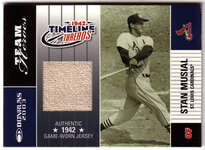The Major League Baseball Authentication Program is the first league-wide memorabilia authentication initiative in professional sports. Since its launch in 2001, it has become the industry standard for autographed and game-used sports memorabilia authentication.
Designed to distinguish officially authenticated MLB memorabilia from other items on the market, the program combines an objective third-party authentication system that guarantees genuine memorabilia for all MLB fans.
Major League Baseball uses a third party authenticator at each and every game, who witnesses all items that received a signature or that were removed from the field. Every item, once witnessed, will receive a sequentially numbered, tamper-proof hologram created by OpSec, U.S. to easily identify its Major League Baseball authenticity.
Once fans receive the piece of memorabilia, they can trace their item using the new, rectangular official authentication numbered hologram through MLB.com. This easy reference enables fans to easily obtain and verify all of the details surrounding their new item.
Since its inception in 2001, Major League Baseball Authentication Program has certified over 3,000,000 items, allowing fans to ensure their memorabilia is a 100% genuine piece of their favorite pastime. It's easy to get the real goods - just check for the official seal of authentication.
Once witnessed, every authenticated item is affixed with a tamper-proof hologram created by OpSec, U.S. to identify its authenticity.
Valediction, I understand your thinking, but in all honesty, who would care? Unless it is a historical event, which the agents would surely recognize and collect/label items, why would we need to know how many times a bat was used by anyone? And if the reps collected & labeled the item, then put it on the market, isn't that all you need to know? It was used in a MLB game. My point was that since each item collected by MLB is assigned a hologram number, it would be easy for the card companies to provide that holo# on a the card back for proof of authenticity.





